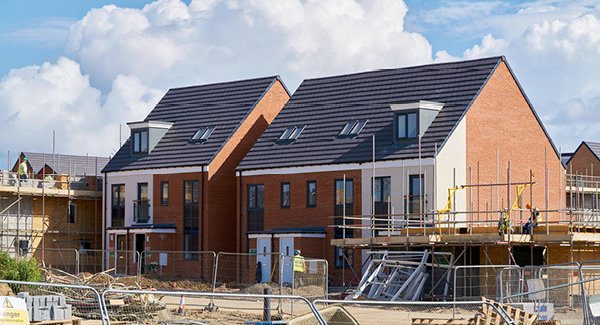A Path Toward Net-Zero Homes for Housing Associations
For most people in the public sector, ‘net-zero’ isn’t an unfamiliar term. As the climate crisis reaches boiling point and global governments start taking action, the UK’s goal has been established — all sectors of the UK economy must be carbon neutral by 2050.
.jpeg?width=1200&name=Optimized-jay-mullings-6aHVWP2zB54-unsplash%20(1).jpeg)
But it isn’t as simple as reducing your carbon footprint and you’re good to go. Decarbonising will require complete overhauls of processes and technologies, particularly in the public sector. We investigate the net-zero target for the UK housing sector, how it can be achieved and how much it is likely to cost.
Why Net-Zero?
The UK government’s Net-Zero Strategy has been to help decarbonise the nation by 2050. While it aims to do this, it also promises to offer more affordable alternatives, develop new industries, innovative technologies and create new jobs to become a more energy secure nation.
This will come more easily for some sectors than others. While the need for a net-zero economy isn’t disputed, the reality of achieving the target isn’t as clear cut.
When addressing the housing sector, the need for change is clear — housing accounts for 15% of the UK’s carbon emissions. As well as releasing the mid-century goal for carbon neutrality, the UK government has also set a target to tackle housing directly by introducing the need for all UK homes to have an energy performance certificate (EPC) rating of C by 2035.
But social housing is a sector already under immense pressure. As the need for social housing increases and budgets, time and costs are tight, the path to net-zero may be more complex.
How Much Is It Likely to Cost?
As we’ve already highlighted, achieving the net-zero goal won’t come without high costs, particularly for housing associations.
Inside Housing have estimated that retrofitting existing homes, making them more energy-efficient and eco-friendly, is likely to cost housing associations over £100 billion.
And there’s also new housing to take into account. Although the government has promised to make more affordable energy-efficient and carbon-neutral alternatives available, the cost of building new social homes — 1.5 million between 2019 and 2022 — is vast.
Is There Any Government Support?
How can the government support housing associations to reach the common goal of carbon neutrality? Funding will have a pivotal part to play.
The Social Housing Decarbonisation Fund (SHDF) has been set up to help housing associations to overhaul the sector. The government has pledged a £3.8 billion investment over the next 10 years to decarbonise social housing.
The initial kick-off of the fund saw the Social Housing Decarbonisation Fund Demonstrator, where over 2,300 homes were improved to EPC Band C and at least 1,300 local jobs were supported.
Since then, additional SHDF funding has been set out in two waves.
Wave 1 offered £160 million to registered providers of social housing, which could be used towards delivering energy-efficient homes, tackling fuel poverty, reducing carbon emissions, supporting green jobs, developing the retrofit sector and more. A further £800m has been promised for Wave 2, which will be available between 2022 and 2025.
In terms of funding for tenants, as part of the SHDF, 20,000 social housing properties will receive energy-efficient upgrades — such as electric heat pumps — and measures to help cut their fuel bills.
How Can This Target Be Achieved?
Housing associations currently own and manage around 2.7 million homes across England, meaning that reaching the net-zero target will be a sizable challenge that’ll require innovation, the transformation of processes and valuable property stock data.
Although it may be a challenge, there will be several benefits for housing associations in the form of additional funding, creating new jobs and future-proofing the social housing sector.
We look into how housing associations can reach the 2035 2050 targets.
Innovation and Technology
Innovation and technology will be the key building blocks to success. The introduction of new eco-friendly housing technologies and solutions will be crucial in helping housing associations to become carbon neutral.
Ground source heat pumps, solar panels and modular homes are all solutions that can and should be introduced to new and existing social housing.
Net-Zero Carbon Construction
As the need for new social housing increases, the opportunity for net-zero carbon construction becomes more popular. With net-zero being a non-negotiable requirement, new social housing properties will need to be built with carbon neutrality front and centre.
This can be achieved by modular housing, using eco-friendly materials and installing innovative technologies that help improve the overall energy efficiency of new homes.
Not only will this help housing associations meet the decarbonisation goal, but it’ll also present the opportunity for new jobs and create cost-saving opportunities for tenants.
Tenant Engagement
Having all stakeholders, including tenants, invested in the end goal will be essential when achieving carbon neutrality for housing organisations.
Getting tenants involved with emissions reductions and initiatives will improve the overall carbon footprint of the social housing sector and encourage them save costs.
Fossil fuel prices are continually rising and are volatile, meaning low-carbon alternatives should be increasingly popular for tenants due to their cost-saving opportunities. As technology improves and costs plummet through low-carbon heating systems, this makes them an obvious option for housing associations and tenants.
Retrofitting Existing Homes
Achieving net-zero doesn’t just focus on new homes, but it’s alsoabout upgrading current properties too. This comes in the form of retrofitting existing homes to make them more energy-efficient.
While concerns surrounding cost and scale are prevalent, the path to success is still achievable. Upgrading current housing with new technologies and solutions will be key, but in some cases, building new properties may be more cost-effective in the long run rather than retrofitting existing housing stock.
Is Net-Zero Achievable for Housing Associations?
There’s no doubt there’s a large challenge ahead for housing associations. Achieving net-zero will require significant assessment, funding, planning and investment to prepare social housing for the future.
Although it may be challenging, the opportunities it presents can outweigh the benefits. Not only will it reduce the carbon footprint of the social housing sector, but innovation, job creation, cost-savings and net-zero carbon construction will also become the norm, future-proofing housing associations, their properties and their tenants.
Looking to Find Out More About Green Opportunities for UK Housing Associations?
Then why not join our next event? At the Future of Housing conference, we aim to unite leadership teams, policymakers and influential figures from across the UK to achieve results.
We’ll cover everything from digital transformation, decarbonisation, demand and supply, and tenant engagement, leaving you with the tools and information you need to succeed.
To register your interest, simply click the link below.




.png)